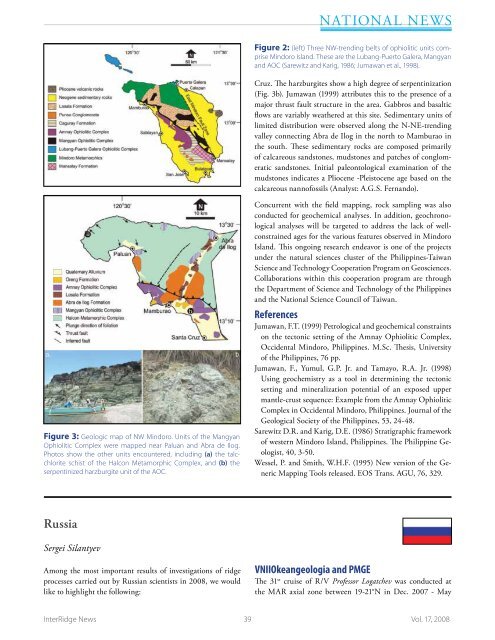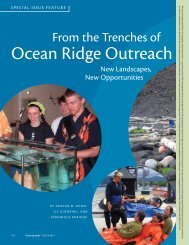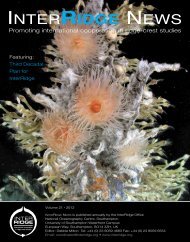Full version, lower resolution, 3.25MB - InterRidge
Full version, lower resolution, 3.25MB - InterRidge
Full version, lower resolution, 3.25MB - InterRidge
You also want an ePaper? Increase the reach of your titles
YUMPU automatically turns print PDFs into web optimized ePapers that Google loves.
National News<br />
Figure 2: (left) Three NW-trending belts of ophiolitic units comprise<br />
Mindoro Island. These are the Lubang-Puerto Galera, Mangyan<br />
and AOC (Sarewitz and Karig, 1986; Jumawan et al., 1998).<br />
Cruz. The harzburgites show a high degree of serpentinization<br />
(Fig. 3b). Jumawan (1999) attributes this to the presence of a<br />
major thrust fault structure in the area. Gabbros and basaltic<br />
flows are variably weathered at this site. Sedimentary units of<br />
limited distribution were observed along the N-NE-trending<br />
valley connecting Abra de Ilog in the north to Mamburao in<br />
the south. These sedimentary rocks are composed primarily<br />
of calcareous sandstones, mudstones and patches of conglomeratic<br />
sandstones. Initial paleontological examination of the<br />
mudstones indicates a Pliocene -Pleistocene age based on the<br />
calcareous nannofossils (Analyst: A.G.S. Fernando).<br />
Figure 3: Geologic map of NW Mindoro. Units of the Mangyan<br />
Ophiolitic Complex were mapped near Paluan and Abra de Ilog.<br />
Photos show the other units encountered, including (a) the talcchlorite<br />
schist of the Halcon Metamorphic Complex, and (b) the<br />
serpentinized harzburgite unit of the AOC.<br />
Concurrent with the field mapping, rock sampling was also<br />
conducted for geochemical analyses. In addition, geochronological<br />
analyses will be targeted to address the lack of wellconstrained<br />
ages for the various features observed in Mindoro<br />
Island. This ongoing research endeavor is one of the projects<br />
under the natural sciences cluster of the Philippines-Taiwan<br />
Science and Technology Cooperation Program on Geosciences.<br />
Collaborations within this cooperation program are through<br />
the Department of Science and Technology of the Philippines<br />
and the National Science Council of Taiwan.<br />
References<br />
Jumawan, F.T. (1999) Petrological and geochemical constraints<br />
on the tectonic setting of the Amnay Ophiolitic Complex,<br />
Occidental Mindoro, Philippines. M.Sc. Thesis, University<br />
of the Philippines, 76 pp.<br />
Jumawan, F., Yumul, G.P. Jr. and Tamayo, R.A. Jr. (1998)<br />
Using geochemistry as a tool in determining the tectonic<br />
setting and mineralization potential of an exposed upper<br />
mantle-crust sequence: Example from the Amnay Ophiolitic<br />
Complex in Occidental Mindoro, Philippines. Journal of the<br />
Geological Society of the Philippines, 53, 24-48.<br />
Sarewitz D.R. and Karig, D.E. (1986) Stratigraphic framework<br />
of western Mindoro Island, Philippines. The Philippine Geologist,<br />
40, 3-50.<br />
Wessel, P. and Smith, W.H.F. (1995) New <strong>version</strong> of the Generic<br />
Mapping Tools released. EOS Trans. AGU, 76, 329.<br />
Russia<br />
Sergei Silantyev<br />
Among the most important results of investigations of ridge<br />
processes carried out by Russian scientists in 2008, we would<br />
like to highlight the following:<br />
VNIIOkeangeologia and PMGE<br />
The 31 st cruise of R/V Professor Logatchev was conducted at<br />
the MAR axial zone between 19-21°N in Dec. 2007 - May<br />
<strong>InterRidge</strong> News 39 Vol. 17, 2008
















